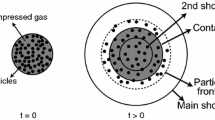Abstract
The bursting sphere model is a simple approach to the numerical simulation of blast from charge detonation. It involves initializing a group of computational cells at high pressure with the correct blast energy to represent the charge volume. In this paper, a programme of numerical simulations of charge detonations in free-field air using the bursting sphere approach will be performed. This is done to investigate the errors in important blast parameters like peak overpressure and impulse that arise due to deviation of the charge shape from an ideal spherical profile when the charge is represented by a Cartesian mesh. This study will also include an assessment of the quality of error estimation for this problem based on grid refinement studies.
Similar content being viewed by others
References
Autodyn user’s manual-version 4.2. Century Dynamics Inc. (1997)
Barth, T.J., Jespersen, D.: The design and application of upwind schemes on unstructured meshes. In: 27th AIAA Aerospace Sciences Meeting (1989). AIAA 89-0366
Baum, J.D., Löhner, R.: Numerical simulation of shock-elevated box interaction using an adaptive finite element shock capturing scheme. AIAA J. 32(4), 682–692 (1994)
Bevins, T.L., Armstrong, B.J., Baylot, J.T., Rickman, D.D.: Multiple building simulations and effect of berms behind blast barrier walls. In: User’s Group Conference (2003)
Brode, H.L.: Numerical solutions of spherical blast waves. J. Appl. Phys. 26, 766–775 (1955)
Cieslak, S., Kheil, S.B., Choquet, I., Merlen, A.: Cut cell strategy for 3-D blast waves numerical simulations. Shock Waves 10, 421–429 (2001)
Clutter, J.K., Mathis, J.T., Stahl, M.W.: Modeling environmental effects in the simulation of explosion events. Int. J. Impact Eng. 34, 973–989 (2007)
De Zeeuw, D.L.: A quadtree-based adaptively-refined cartesian-grid algorithm for solution of the euler equations. Ph.D. thesis, The University of Michigan (1993)
Huntington-Thresher, W.K.E., Cullis, I.G.: TNT blast scaling for small charges. In: 19th International Symposium of Ballistics, pp. 647–654 (2001)
Hyde, D.W.: CONWEP: Conventional weapons effects program. Waterways Experiment Station, Vicksburg (1991)
Kinney, G.F.: Explosive Shocks in Air, 2nd edn. Springer, Berlin (1985)
Lee, E.L., Horning, H.C., Kury, J.W.: Adiabatic expansion of high explosive detonation products (1968). University of California Report No. UCRL-50422
Pullin, D.I.: Direct simulation methods for compressible inviscid ideal-gas flow. J. Comput. Phys. 34(2), 231–244 (1980)
Richardson, L.F.: The approximate arithmetical solution by finite differences of physical problems involving differential equations, with an application to the stresses in a Masonry dam. Trans. R. Soc. Lond. Series A 210, 307–357 (1908)
Ritzel, D.V., Matthews, K.: An adjustable explosion–source model for CFD blast calculations. In: 21st International Symposium on Shock Waves (1997). Paper 6590
Roache, P.J.: Quantification of uncertainty in computational fluid dynamics. Annu. Rev. Fluid Mech. 29, 123–160 (1997)
Roache, P.J.: Verification and Validation in Computational Science and Engineering. Hermosa, Albuquerque (1998)
Rose, T.A.: An approach to the evaluation of blast loads on finite and semi-infinite structures. Ph.D. thesis, Cranfield University, Engineering Systems Department (2001)
Rose, T.A., Smith, P.D.: Development of an adaptive mesh CFD code for high explosive blast simulation. In: Proceedings of the 12th International Symposium on Interaction of the Effects of Munitions with Structures, New Orleans (2005)
Rose, T.A., Smith, P.D., Brittle, M.: Analysis of a generic cityscape using an adaptive mesh CFD code. In: Proceedings of the 12th International Symposium on Interaction of the Effects of Munitions with Structures, New Orleans (2005)
Tang, J.: A simple axisymmetric extension to virtual cell embedding. Int. J. Numer. Methods Fluids 55(8), 785–791 (2007)
Timofeev, E., Voinovich, P., Takayama, K.: Adaptive unstructured simulation of three-dimensional blast waves with ground surface effect. In: 36th Aerospace Sciences Meeting and Exhibit (1998). AIAA 98-0544
Van Leer, B.: Towards the ultimate conservative difference scheme. V. A second order sequel to Godunov’s method. J. Comput. Phys. 32, 101–136 (1979)
Wada, Y., Liou, M.S.: An accurate and robust flux splitting scheme for shock and contact discontinuities. SIAM J. Sci. Comput. 18(3), 633–657 (1997)
Author information
Authors and Affiliations
Corresponding author
Additional information
Communicated by E. Timofeev.
Rights and permissions
About this article
Cite this article
Tang, J. Free-field blast parameter errors from Cartesian cell representations of bursting sphere-type charges. Shock Waves 18, 11–20 (2008). https://doi.org/10.1007/s00193-008-0133-2
Received:
Accepted:
Published:
Issue Date:
DOI: https://doi.org/10.1007/s00193-008-0133-2




